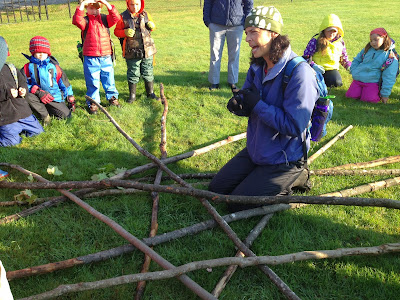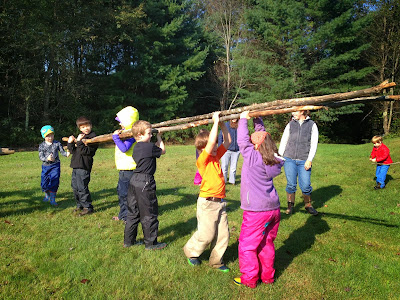This autumn I have spent hours cutting 2 foot long sticks in the forest behind my home. I also have a collection of sticks that are just a foot long and then a random assortment of sticks with twists and curves, just to shake it up a bit. With all these sticks piled in the back of my car it looks as if I am ready for a big camp fire. That's what most people think, but it's the exact opposite.
These are my "math sticks" or my "teaching sticks", not to get confused with plain old firewood! I have been bringing these to the schools I work with through the ECO program and have found many creative uses for them, primarily involving math.
We started out by asking students to make a shape where both ends of the sticks were touching the ends of other sticks. Each child got a stick and was invited one at a time to place their sticks in the growing shape. This took some coaching and guiding in the beginning, but these 1st and 2nd graders caught on quickly and came up with this sequence:
 |
| Do you see a triangle? |
 |
| Triangles become a popular theme |
 |
| The last stick is added |
After the last stick was added the ideas started pouring out.
"It looks like a space ship!'
"No,..it looks kind of like the Ferris Wheel I rode on this summer!"
"If we moved that stick we could have a house or a,.."
With the children's observations teachers took the opportunity to introduce and use math language. Polygons, square, rectangle, angles, rhombus, nonagon, acute, obtuse, parallel,... and it went on and on! The children were eager to create there own pictures with their own rules. Soon 50 sticks was not nearly enough for these students. Especially when it comes to making a giant robot or telling the story of Lightning Heart.
 |
| The Evolving Robot |
 |
| The story of Lightning Heart |
On another day I arrived at school with 12 maple saplings strapped to the top of my car. The poles measured at about 8 feet and I dumped them in a pile on the ball field. The children circled up around the poles wondering what we were about to do. My idea was to lug these to the top of the hill and create tripods across the landscape. Before we even started our work we just looked, and looked some more. With Mrs. C's help, we began to make out all sorts of shapes and shared with our neighbors what we saw.
 |
| Mrs. C just loves math |
 |
| Sharing what we see |
Children climbed over the pile pointing out their shape and naming it with their partner. The challenge was to not name the same shape twice. These students worked hard with sustained focus and found so many polygons. And what a surprise! If you moved one pole ever so much,..the shapes changed!
Once bodies started to wriggle, we had the children grab the poles in true "pick-up-stick" style and carry them to the top of the hill. Who knew math would be so much physical work!
I think I see some team work happening,...
 |
| Here we go |
 |
Up the hill
Once everyone was to the top of the hill we tied on colorful pieces of cloth to the poles. Then began the problem solving around how to erect a tipi! The children were not the only challenged ones. The adults were figuring out right along side of them.
|
 |
| Many hands make light work |
 |
| Whew! Is it snack time yet? |
In the end, the children celebrated with snack and a story under their tipi's and wondering what else they could build with sticks in the forest. More sticks, more math please!
Thinking about standards and what we learned? Read the following standards included in our lesson Stick Shapes.
Common
Core Math Standard:
CCSS.Math.Content.K.G.A.1 Describe
objects in the environment using names of shapes, and describe the relative
positions of these objects using terms such as above, below, beside, in
front of, behind, and next to.
CCSS.Math.Content.K.G.B.5 Model
shapes in the world by building shapes from components (e.g., sticks and clay
balls) and drawing shapes.
CCSS.Math.Content.K.G.B.6 Compose
simple shapes to form larger shapes. For example, “Can you join these
two triangles with full sides touching to make a rectangle?”
A big thank you to Juliet Robertson and Creative Star Learning for the inspiration for these lessons! You can find her work here:
http://creativestarlearning.co.uk/














